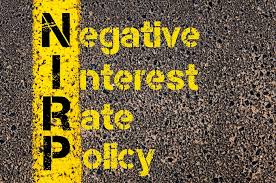 Some fun reading . . .
Some fun reading . . .
We struggled to get our V’pac mind around the concept as it has cropped up in business and other news articles a lot lately. Linked and excerpted below are a couple of articles that provide some explanation.
We new the economic implications were not the same as bank service charges for checking accounts — the practice of many if not most banks to charge you monthly fees to hold your money (usually when it is below some threshold amount) in a checking account and whether or not you write any number of checks. While that checking account is a “demand deposit” the bank is charging you for the privilege of holding it “safely.”
The way interests rates are today they may pay you a tiny percentage but the fees charge eclipse that amount in those types of accounts. In a manner of speaking it is a negative interest rate. However when it comes to the scale of your bank’s deposits with the central banking system, used to carry on both of their affairs, the implications are much different.
Your local bank is charging you fees on checking account deposits that you can affect or eliminate by altering your deposit type or pulling them out. With such fees your bank more than covers its costs we suspect and the service fees are then a profit center, a net negative interest rate of sorts to you but with not a particularly discernible grand manipulative effect on the economy. It is just another cost of doing business or a convenience fee.
So along comes the idea of the bigger bank charging those smaller banks for the privilege of keeping “their” (largely your) funds, enough to have some effect on your bank’s loan policies. The purpose is to discourage your bank from keeping deposits and instead loaning money out in order to stimulate economic activity. But what could go wrong with that . . . artificial stimulants to give loans they would not otherwise give or, as costs are passed on, driving depositors away from banks thus reducing available deposits to loan? Nothing to worry about at all.
From Bloombergview.com Negative Interest Rates Less Than Zero
By Jana Randow and Simon Kennedy
Imagine a bank that pays negative interest. Depositors are actually charged to keep their money in an account. Crazy as it sounds, several of Europe’s central banks have cut key interest rates below zero and kept them there for more than a year. Now Japan is trying it, too. For some, it’s a bid to reinvigorate an economy with other options exhausted. Others want to push foreigners to move their money somewhere else. Either way, it’s an unorthodox choice that has distorted financial markets and triggered warnings that the strategy could backfire. If negative interest rates work, however, they may mark the start of a new era for the world’s central banks.
(snip)
Negative interest rates are an act of desperation, a signal that traditional policy options have proved ineffective and new limits need to be explored. They punish banks that hoard cash instead of extending loans to businesses or to weaker lenders.
(snip)
Policy makers in both Europe and Japan are trying to prevent a slide back into deflation, or a spiral of falling prices that could derail the economic recovery. The euro zone is also grappling with a shortage of credit and unemployment is only slowly receding from its highest level since the currency bloc was formed in 1999.
The Argument
In theory, interest rates below zero should reduce borrowing costs for companies and households, driving demand for loans. In practice, there’s a risk that the policy might do more harm than good. If banks make more customers pay to hold their money, cash may go under the mattress instead. Deutsche Bank economists note that negative rates haven’t sparked the bank runs or cash hoarding some had feared, in part because most banks haven’t passed them on to their customers. But there’s mounting concern that when banks absorb the cost themselves, that squeezes the profit margin between their lending and deposit rates, and might make them even less willing to lend.
In related reading is this Reuters article by Jamie McGeever:
Markets betting on near-zero interest rates for another decade
LONDON (Reuters) – World markets may have recovered their poise from a torrid start to the year, but their outlook for global growth and inflation is now so bleak they are betting on developed world interest rates remaining near zero for up to another decade.
Even though the U.S. Federal Reserve has already started what it expects will be a series of interest rate rises, markets appear to have bought into a “secular stagnation” thesis floated by former U.S. Treasury Secretary Larry Summers.
The idea posits that the world is entering a peculiarly prolonged period in which structurally low inflation and wage growth – hampered by aging populations and slowing productivity growth – means the inflation-adjusted interest rate needed to stimulate economic demand may be far below zero.
As there’s likely a lower limit to nominal interest rates just below zero – because it’s cheaper to hold physical cash and bank profitability starts to ebb – then even these zero rates do not gain traction on demand.
For all the debate about the accuracy of that view, it’s already playing out in world markets, with long-term projections from the interest rate swaps market showing developed world interest rates stuck near zero for several years.
More of the Reuters article here.
Also: Negative Interest Rate Policy (NIRP)
3 Dangers of a Negative Interest Rate Policy
Here’s Why Negative Interest Rates May Not Be Good for You
R Mall
